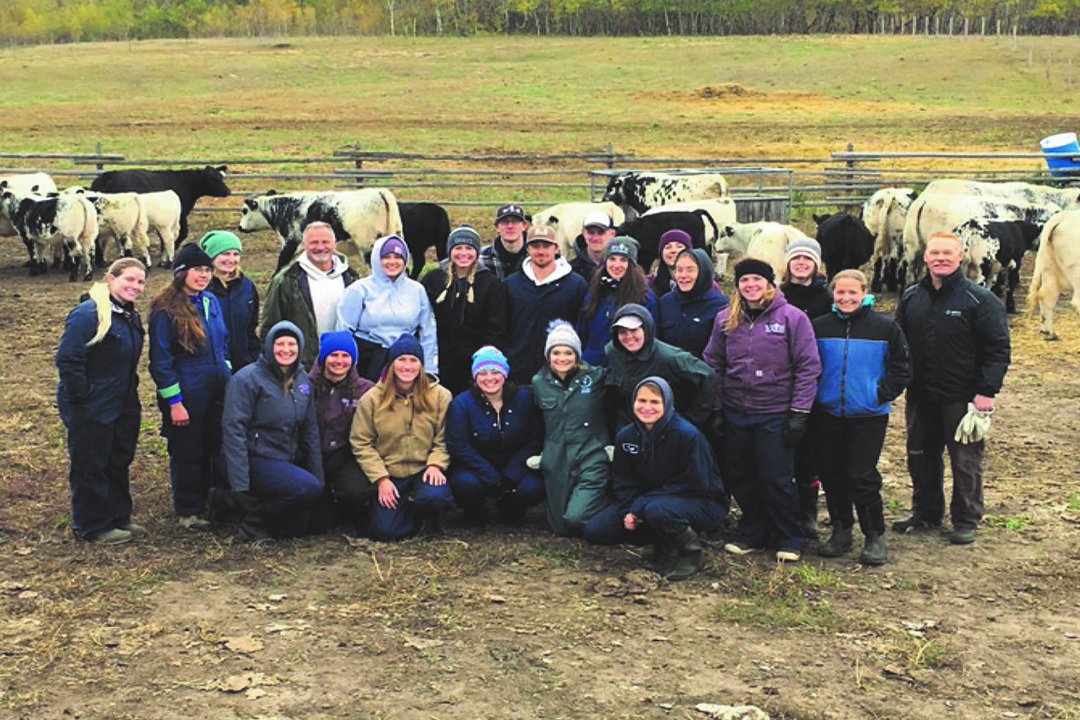
Leading by example
As I walk down the halls at the Western College of Veterinary Medicine (WCVM), I pass by walls lined with graduation portraits dating back to the first students in the 1960s. From a then-majority of sepia-toned moustaches to today’s colour photos featuring predominantly female students, we can spot the faces of our mentors, many of our teachers, and for some, even family members.
By Chloe GustavsonTradition is in these hallways. A few weeks into third year, our first lecturer of the morning opened with a rhetorical question: “We always hear that students want to learn from motivated teachers. What about the teachers wanting motivated students?”
I believe that each side of the classroom shows up every day because both sides of the question are certainly true. When our teachers say to us that they have been in our seats and they know what it feels like, it is genuine.
This past summer, an internationally-trained veterinarian asked me what WCVM is known for. While we instinctively began discussing academic achievements and notable contributions to the veterinary profession at large, these merits should not be separated from the dedication that is shown within our own community.
We are privileged to be learning from veterinarians who bring clinical experience to their lectures, highlighting its relevance, and engaging our interest. When learning about changes in the pregnant mare in equine theriogenology, our lecturer invites us down to the clinic to visit a foal born just the day before. When we consult the online Merck Veterinary Manual and see a familiar faculty name as contributing author, the impact resounds.
Our teachers are devoted to our profession and our school, and their support to students extends outside of the lecture hall and beyond office hours. Like us, our professors are animal people. Many bring their pets to school, and we benefit from their presence. Whether they are sport dogs volunteering in physiology labs, motivated cats participating in rehabilitation demonstrations, or simply the tail-wagging recipients of our affection, they enhance our learning while positively benefitting our mental health.
For larger species, our teachers invite students off-campus to see their animals. There have been opportunities for experienced horse riders to get in the saddle, as well as handling labs offered to those seeking further experience around cattle.
When we take a break from learning, our teachers are there, too. Last year a group of musically talented students, harmonizing as the WCVM Orchestra, sought out to start a new tradition called Hootenanny. For the past two years, they have performed a fall concert in a barn loft belonging to a generous and admired professor.
Later in the year, prior to the start of December final exams, another favourite student activity at the WCVM is holiday carolling. Each class arranges a school bus to drop us off outside the homes of a few of our professors (who have previously agreed to accommodate a choir of over 70 on their front lawns).
Dressed in festive sweaters, we give our best effort at spreading cheer with enthusiastic carol singing and are then welcomed inside. The warmth of mulled wine on a Saskatchewan winter evening radiates the kindness we are shown by our teachers and their families (four-legged members included, of course). It is heartening to hear that they also look forward to the annual event as a memorable start to the Christmas season.
I hope that as students we are effective in demonstrating our appreciation, abiding by the so-called golden rule of the classroom. Each April, when we are asked to reflect upon our curriculum and offer course feedback, we also take the opportunity to collectively recommend exceptional instructors for awards that recognize their commitment to our education.
At the end of our first year, my class was successful in nominating our anatomy lab professor, Dr. Brent Bobick, for a Teaching Excellence Award in Instructional Support awarded by the University of Saskatchewan’s Student Union. On our submissions, we referenced his encouraging enthusiasm, his proficiency in making complicated concepts easily understood, and — most admirably — that word of our nomination propelled him to make veterinary anatomy labs even better for the next year’s class.
The more time we spend here, the more aware we become of just how dedicated so many of our teachers are as true educators; they lead by example.
WCVM students come from the four western provinces, Yukon, and Northwest Territories; and Saskatoon and the WCVM become a home-away-from-home for many of us. We often hear that the WCVM community will continue to be here for us in our post-graduation lives. Our professional inquiries can turn into teaching material, and the support self-perpetuates.
Here, we have many role models to look up to as we make the transition from students to teachers ourselves. We see the emphasis placed on being part of a team. To the veterinary technicians, graduate students, interns and residents who are patient with our questions and readily share their wealth of knowledge, we are so thankful for your help. In true holiday spirit, I would like to formally express gratitude to the faculty and staff at WCVM who go above and beyond.
To learn more about life at the WCVM with our #pawesomeprofessors, follow us throughout the year on student-run social media: @wcvsa #studentsoftheWCVSA, facebook.com/WCVSA.
Chloe Gustavson obtained a BSc from the University of Victoria prior to coming to WCVM. She calls Vancouver’s North Shore home, where she most enjoys spending time near the ocean with her dog, Leo. Upon graduation she plans to return to BC to work in small animal practice.
This story originally appeared in West Coast Veterinarian, the magazine of the Canadian Veterinary Medical Association-Society of British Columbia Veterinarians (CVMA-SBCV) Chapter.
